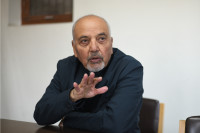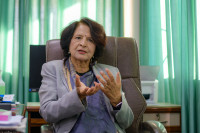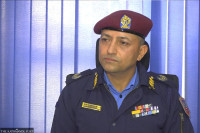Interviews
Longer the delay in spending available funds, harder it will be to secure new funds
Last Wednesday, the government sacked Sushil Gyewali as Chief Executive Officer (CEO) of the National Reconstruction Authority (NRA) after it found the two clarifications he furnished about delays in post-earthquake rebuilding works unsatisfactory.
Last Wednesday, the government sacked Sushil Gyewali as Chief Executive Officer (CEO) of the National Reconstruction Authority (NRA) after it found the two clarifications he furnished about delays in post-earthquake rebuilding works unsatisfactory. Subsequently, the government has re-appointed Govind Raj Pokharel as the new NRA chief. The Sushil Koirala government had appointed Pokharel as the first head of the reconstruction body in August 2015 through an ordinance. Failure to convert the ordinance into a bill had led the KP Oli government to replace Pokharel by Gyewali in December that year. Pokharel’s reinstatement now comes amid criticism over the lacklustre performance of the NRA, which has compelled thousands of quake victims to spend their second winter under makeshift tents. Mukul Humagain and Binod Ghimire spoke with Pokharel about the inevitability of politicisation of the NRA efforts, his priorities as the new NRA chief and the institutionalisation of the reconstruction efforts so that they are insulated from political upheavals.
Was your re-appointment as the NRA chief a result of reconstruction needs or was it a political compulsion due to a change in government?
The reason behind the NRA’s establishment was to build coordination among various ministries and to develop a system that would perform in a more innovative manner. Failure to coordinate would result in the lack of desired output. The chances of such a failure become high if the NRA cannot take the government into confidence. So the NRA’s purpose of existence is lost if it cannot establish trust with the government, foster coordination among various stakeholders and deliver results.
But how do you allay the general concern that even if someone heading the NRA delivers, he will again be replaced once there is a change in government?
The most important thing is the system. Leadership is only about establishing trust and confidence. If there is a good system in place, the change in leadership does not make much of a difference. But if there is excessive centralisation of power and a one-man show, the change in leadership can have an impact. So if you keep the system intact and confine the leadership’s role to coordinate at the macro level, the system will continue functioning even if the leadership changes. Political transition happens not only in Nepal but in other countries as well, but the important thing is to create a mechanism that is impervious to the transition.
How have you assessed the work of the NRA so far?
We had drafted a reconstruction policy and working modality, which was approved by the NRA under the previous leadership. A reconstruction policy, which was endorsed by the National Planning Commission, was also approved. A few other working modalities have been worked out. There have been attempts at formulating some systems, especially of documentation. There have been some surveys and training programmes. But there have been massive shortcomings in the mobilisation of human resources and in coordination and collaboration. We have to build on what has been done in the past year and work in accordance with what the Post Disaster Needs Assessment (PDNA) report had envisaged.
Specifically, how will the NRA move forward in the days ahead so as to ensure the quake survivors do not have to spend their third monsoon under makeshift tents?
Our priorities will be to foster effective coordination and collaboration and to establish a robust monitoring mechanism so as to prevent the misuse of funds. Everybody should work efficiently, effectively and transparently. Many (I)NGOs are working in parallel on reconstruction and there is a lot of duplication. Everyone should have space to work, including the private sector which is currently missing from reconstruction works, and yet avoid duplication. We are holding meetings with cement, bricks and corrugated iron sheets suppliers this week in coordination with the ministry of supplies, for example.
What of the funding gap and the reconstruction needs?
There is a massive need for the deployment of human resources and the mobilisation of reconstruction funds to bridge the funding gap. We have also requested the prime minister, who is the chancellor of the country’s universities, to mobilise student volunteers to disseminate vital information about reconstruction, which our technical staff may not do. Moreover, we will conduct masonry training in 250 VDCs from the second week of February. Our immediate goal is to address the shortages of construction materials, skilled human resources and government employees. We are moving forward with the goal of constructing the majority of houses before monsoon.
What kind of a monitoring mechanism will you put in place?
We want to adopt a supportive and positive incentive model rather than a punitive one. We want quake survivors to realise that they will get the subsequent instalments of funds if they use the previous ones to build their house. At present, people lack a motivational package to construct houses. There is a shortage of one or more of the necessities—either money or construction materials or technical human resources. Something or the other is missing, making it difficult for people to build houses. Our data show that fewer than 30,000 houses that meet our specifications have been built. So our main challenge now is synchronisation, which we will be working towards addressing.
There seems to be a widespread perception among quake survivors that it is the government that will build their houses. How will you drive home the point that the government is only playing a supportive role?
More than that, people lack the motivation and the supportive environment to start digging the foundation of their houses with the first instalment of the housing aid they received. I think the perception that you mentioned has already been more or less dispelled. It is not the lack of right information but rather the lack of synchronisation required to build houses that seems to be a major stumbling block.
How do you intend to bridge the funding gap that you mention?
There is certainly a huge funding gap at the moment. The increased grant of Rs300,000 per household amounts to a large sum. We should spend the money we have on hand. The grants from India and China have not been mobilised, for example. The grant from the International Monetary Fund has been cleared only recently. The government has not been able to spend what it has allocated. The longer the delay in spending, the lower the chances of securing more grants.
How can you assure that you will be able to do what the NRA under the previous leadership could not?
One aspect is motivational. I am trying to motivate various stakeholders to undertake different aspects of reconstruction. Another is that some reforms in the NRA are necessary. There is a shortage of staff, for example. Of the 140 positions, we have filled only 50. I will first try to fill that gap by bringing in those government employees who are interested to work for the NRA. Second, I will try to decentralise some of the tasks by assigning everyone particular responsibilities so that they feel a sense of ownership. There should be regular meetings with the ministries. I am meeting the health minister, for example, to figure out what can be done to help those survivors who are vulnerable from a health point of view. I am meeting the minister of supplies to hold a meeting with private suppliers. I just met with the officials from the department of housing and the Council for Technical Education and Vocational Training (CTEVT).
What about the issues of identification of vulnerable settlements and relocation?
A committee for this purpose had been formed, but it has not come up with its report. I will be assigning specific tasks regarding relocation and addressing of grievances. On Thursday, we cleared around 70,000 grievances. There are still nearly 200,000 more.
How feasible is relocation since people are attached to the places where they come from?
Relocation has to take place in a nearby area so that people’s livelihood is not affected. But if studies have shown that certain areas are vulnerable, we cannot let people continue living in those places. The process of relocation has already been delayed, so we must address it urgently. Since many places have only old people and children, we need to explore if and how we can get the private sector involved in constructing new settlements.
As a political appointee yourself, how do you intend to tackle politicisation in the NRA?
Since we are a democratic country, some amount of politicisation is inevitable. I may not be in the NRA when the government that appointed me is no longer there. But the important thing is to establish a mechanism that will ensure that the organisation will keep functioning even when the person heading the organisation has to leave. You have not done a good job if the organisation collapses as soon as you leave.
In one of your earlier interviews, you had stated that 70 percent of the NRA staff will be government employees and the rest will be hired on a contract basis. Is that still relevant?
Yes, we have to hire on a contract basis. Without that we cannot deliver. Many government employees are overworked. This issue has to be addressed.




 17.12°C Kathmandu
17.12°C Kathmandu











